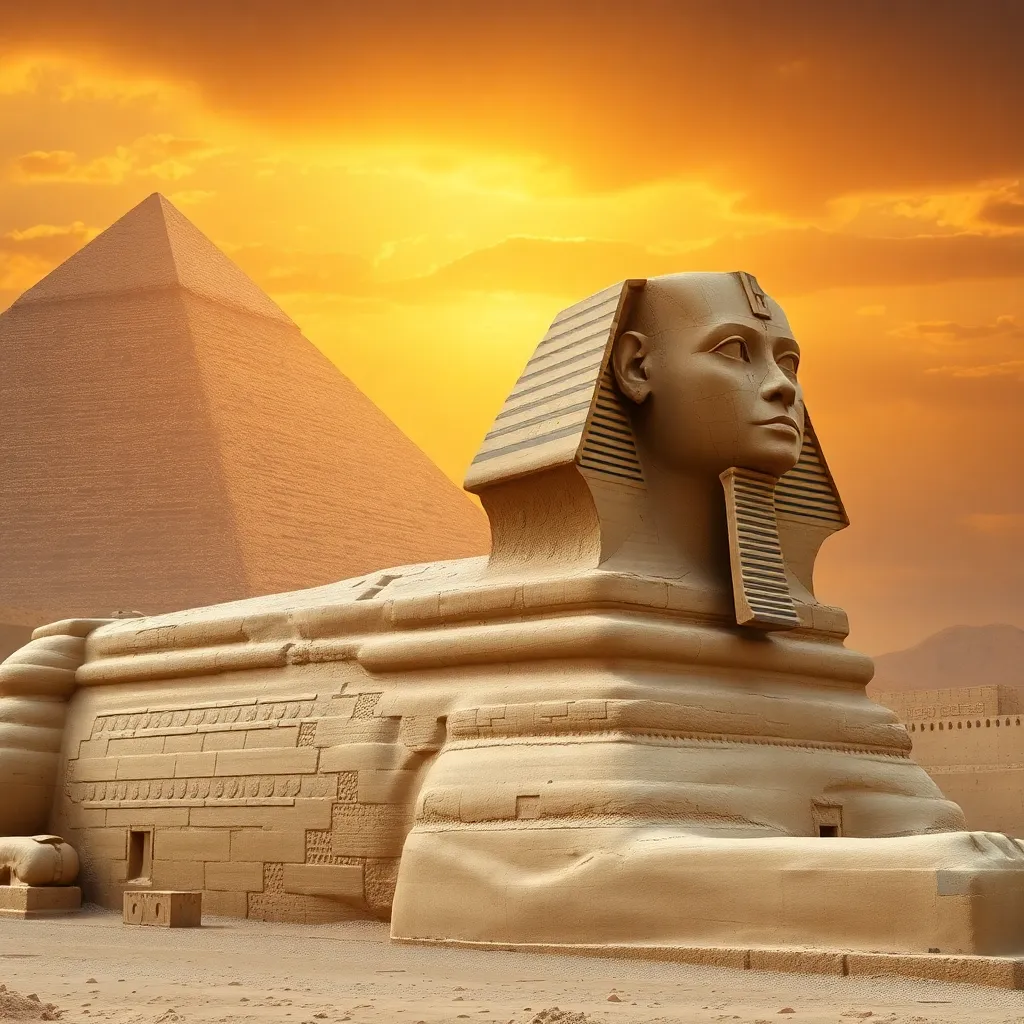The Sphinx and Its Connection to the Egyptian Pantheon
I. Introduction
The Great Sphinx of Giza, one of the most iconic monuments of ancient Egypt, stands as a testament to the ingenuity and artistry of the ancient Egyptians. Carved from limestone and featuring the body of a lion and the head of a human, the Sphinx holds a crucial place in the history and culture of ancient Egypt.
In ancient Egyptian culture, the Sphinx symbolized a deep connection between the earthly and the divine, serving not only as a monumental figure but also as a guardian of sacred spaces. This article aims to explore the significance of the Sphinx within the context of Egyptian mythology, its symbolism, and its connections to various deities in the Egyptian pantheon.
II. Historical Context of the Sphinx
The Great Sphinx is believed to have been constructed during the reign of Pharaoh Khafre, around 2500 BCE. This dating places it in the Old Kingdom period, a time of monumental architecture and the flourishing of Egyptian civilization.
There are several theories regarding the original purpose of the Sphinx. Some scholars suggest it was a guardian figure intended to protect the nearby pyramids, while others believe it served as a representation of the pharaoh himself, embodying the divine qualities of strength and wisdom. Its position on the Giza Plateau, adjacent to the Great Pyramid, reinforces its significance in the funerary complex.
III. Symbolism of the Sphinx
The Sphinx’s hybrid form, combining the body of a lion and the head of a human, holds rich symbolism. The lion represents power and ferocity, while the human head signifies intelligence and wisdom. Together, they embody a balance of strength and knowledge, crucial traits for a guardian.
Additionally, the Sphinx is associated with the concept of guardianship. It is often depicted as a sentinel watching over sacred sites, emphasizing its role in protecting the pharaoh and the divine order represented by the pyramids.
IV. The Sphinx in Egyptian Mythology
In Egyptian mythology, the Sphinx plays a significant role in the narratives surrounding Osiris and Horus. Osiris, the god of the afterlife, and Horus, the god of the sky, embody the themes of death, resurrection, and kingship, all of which resonate with the Sphinx’s protective nature.
The Sphinx served as a protector of sacred spaces, much like the griffins and other mythical creatures found in various mythologies. Its presence symbolized the safeguarding of divine knowledge and the afterlife.
V. The Sphinx and the Egyptian Gods
The Sphinx has strong connections to the sun god Ra. In ancient Egyptian religion, Ra was often depicted as a lion or a lion-headed figure, linking the Sphinx’s leonine form to the sun’s power and its life-giving attributes.
Furthermore, the Sphinx is seen as an embodiment of Ma’at, the principle of truth, balance, and cosmic order. This connection emphasizes the importance of harmony in the universe, which was a core belief in ancient Egyptian thought.
In funerary practices, the Sphinx played a role in guiding the souls of the deceased to the afterlife, reinforcing its significance as a protective figure.
VI. Artistic Representations of the Sphinx
The Sphinx is prominently featured in ancient Egyptian art and literature. It appears in various forms, from sculptures to wall reliefs, often depicted alongside pharaohs and gods. These representations highlight its importance as a symbol of power and protection.
- In literature, the Sphinx is often associated with riddles and wisdom.
- In art, it is depicted in colossal forms, showcasing the skill of ancient Egyptian artisans.
The influence of the Sphinx extends beyond ancient Egypt, impacting subsequent cultures and civilizations, including the Greeks, who adopted the Sphinx as a symbol of mystery and enigma in their own mythology.
Modern interpretations of the Sphinx continue to inspire artists, filmmakers, and writers, reflecting its lasting legacy in contemporary culture.
VII. Archaeological Discoveries Related to the Sphinx
Recent archaeological discoveries have shed new light on the Sphinx and its surroundings. Excavations around the Giza Plateau have revealed structures and artifacts that provide insight into the Sphinx’s construction and the society that built it.
The ongoing debates about the Sphinx’s purpose and significance highlight the complexities of understanding ancient Egyptian civilization. Scholars continue to explore its origins, and new technologies are being employed to uncover hidden features and inscriptions.
Preservation efforts are also crucial, as the Sphinx faces challenges from environmental factors and tourism. Maintaining its structural integrity is essential for future generations to appreciate this monumental icon.
VIII. Conclusion
In summary, the Sphinx holds a profound connection to the Egyptian pantheon, serving as a symbol of strength, wisdom, and divine protection. Its role in ancient Egyptian mythology, art, and architecture underscores its importance in the cultural landscape of ancient Egypt.
The enduring legacy of the Sphinx continues to resonate in contemporary culture, inspiring awe and curiosity. Understanding the Sphinx not only enriches our knowledge of ancient symbols but also deepens our appreciation for the complexity and depth of Egyptian mythology.
Ultimately, the Great Sphinx of Giza remains a timeless monument that bridges the past and present, inviting us to explore the mysteries of ancient civilizations.




